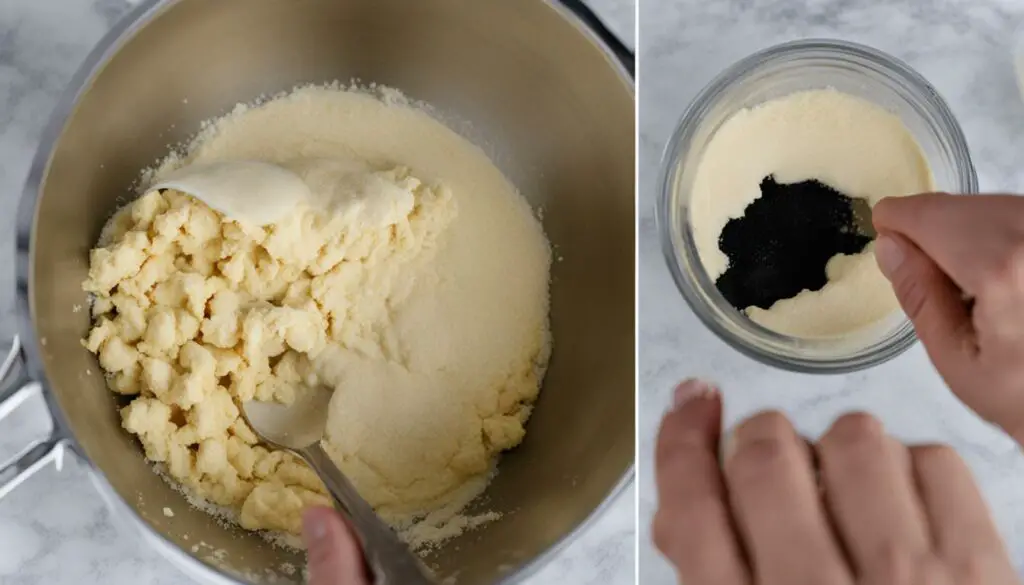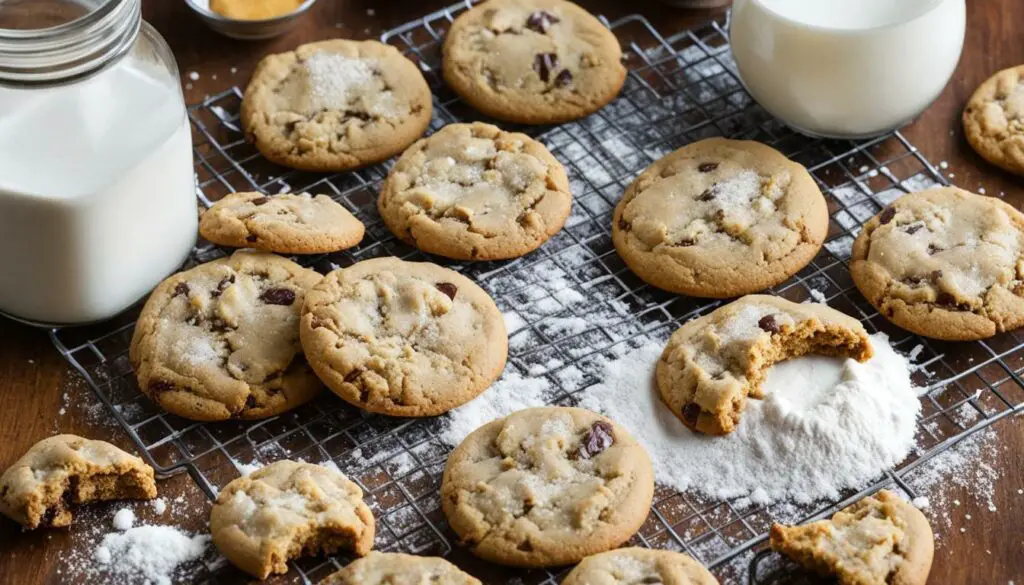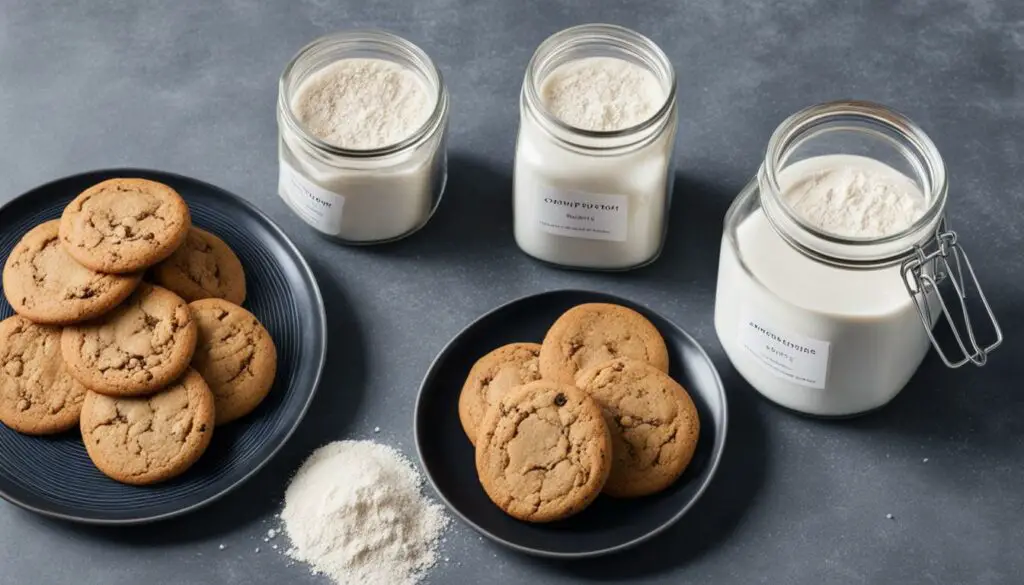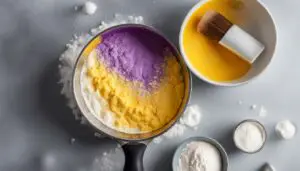Originally posted on January 9, 2024 @ 6:13 am
Cornstarch is a secret ingredient that can take your cookies from good to amazing. Have you ever wondered what does cornstarch do in a cookie recipe? Well, let’s dive in and discover the benefits of adding cornstarch to cookie dough and the various uses of cornstarch in baking cookies.
Contents
- 1 How Does Cornstarch Affect Cookie Texture?
- 2 Why Use Cornstarch in Cookies?
- 3 How to Use Cornstarch in Cookie Recipes
- 4 Other Benefits of Using Cornstarch in Cookies
- 5 Recipes and Tips for Using Cornstarch in Cookies
- 6 Cornstarch Alternatives in Cookie Recipes
- 7 Baking Tips for Using Cornstarch in Cookies
- 8 Conclusion
- 9 FAQ
- 9.1 What does cornstarch do in a cookie recipe?
- 9.2 What are the benefits of adding cornstarch to cookie dough?
- 9.3 How does cornstarch affect cookie texture?
- 9.4 What is the role of cornstarch in making cookies?
- 9.5 Why use cornstarch in cookies?
- 9.6 How to use cornstarch in cookie recipes?
- 9.7 What are the other benefits of using cornstarch in cookies?
- 9.8 What are some recipes and tips for using cornstarch in cookies?
- 9.9 What are some cornstarch alternatives in cookie recipes?
- 9.10 What are some baking tips for using cornstarch in cookies?
- 10 Source Links
Key Takeaways:
- Cornstarch contributes to the texture and thickness of cookies.
- It creates a tender and soft texture in cookies.
- Cornstarch can help control the spreading of cookies, resulting in a thicker final result.
- Using cornstarch in cookies enhances their overall taste and adds a touch of sweetness.
- Cornstarch helps to prolong the shelf life of cookies, keeping them fresh for longer.
How Does Cornstarch Affect Cookie Texture?

When it comes to baking cookies, it’s important to understand the role that cornstarch plays in creating the desired texture. Adding cornstarch to your cookie dough can have a significant impact on the final result, influencing factors such as cookie spread, tenderness, and thickness. Let’s explore the effects of cornstarch on cookie texture in more detail.
The Role of Cornstarch in Making Cookies
Cornstarch is a powdery ingredient that acts as a thickening agent and helps to modify the texture of baked goods. In cookies, cornstarch serves two primary purposes:
- Creating a softer and more tender cookie
- Controlling the spreading of cookies during baking
Let’s delve into each of these effects:
Influence of Cornstarch on Cookie Spread
When cookies spread too much during baking, they can end up thin and crispy. Cornstarch helps to counteract this by absorbing moisture and limiting the spreading of the cookies. As a result, cookies made with cornstarch tend to have a more compact and thicker texture, with less spread. This can be particularly useful when baking cookies that require a denser consistency, such as chocolate chip or shortbread cookies.
Effects of Cornstarch on Cookie Texture
The presence of cornstarch in cookie dough also affects the overall tenderness of the cookies. When combined with other dry ingredients, cornstarch helps to inhibit the formation of gluten. Gluten is a protein that gives structure and elasticity to baked goods, but too much gluten can make cookies tough and chewy. By inhibiting gluten formation, cornstarch contributes to a more delicate and melt-in-your-mouth texture in cookies.
To summarize, the addition of cornstarch in cookie dough can result in cookies that are thicker, more tender, and less spread. It’s worth experimenting with different amounts of cornstarch in your favorite cookie recipes to achieve the desired texture.
“By inhibiting gluten formation, cornstarch contributes to a more delicate and melt-in-your-mouth texture in cookies.”
Now that we understand the effects of cornstarch on cookie texture, let’s explore why using cornstarch in cookies is beneficial.
| Effects of Cornstarch on Cookie Texture | Benefits of Using Cornstarch in Cookies |
|---|---|
| Creates a softer and more tender cookie | Enhances the overall taste and flavor |
| Controls the spreading of cookies during baking | Extends the shelf life of cookies |
| Improves moisture retention in cookies | Achieves a more visually appealing appearance |
Why Use Cornstarch in Cookies?

Using cornstarch in cookies offers several benefits that can greatly enhance your baking experience. Let’s explore why cornstarch is a valuable ingredient to consider:
Improved Texture: When you add cornstarch to your cookie dough, it can significantly improve the texture of the cookies. The presence of cornstarch creates a softer, more tender consistency, resulting in cookies that practically melt in your mouth.
Enhanced Flavor: Not only does cornstarch improve the texture, but it also adds a subtle touch of sweetness and a hint of vanilla-like flavor to the cookies. This addition enhances the overall taste and elevates your cookie baking to another level.
Extended Shelf Life: Another advantage of using cornstarch in cookies is its ability to prolong the shelf life of the finished treats. Cornstarch helps to retain moisture in the cookies, keeping them fresh and delicious for a longer period of time.
“Using cornstarch in cookies not only improves the texture and flavor but also helps the cookies stay fresh for a longer time.”
How to Use Cornstarch in Cookie Recipes

Using cornstarch in cookie recipes is quite simple. There are two main methods for incorporating cornstarch into your dough.
Method 1: Adding to Dry Ingredients
The first method involves adding cornstarch directly to the dry ingredients and mixing it in with the flour.
- Measure the desired amount of cornstarch.
- Sift the cornstarch along with the flour and other dry ingredients to evenly distribute it throughout the dough.
- Proceed with the recipe as usual, following the instructions for mixing and baking.
Method 2: Combining with Liquid
The second method involves combining cornstarch with a small amount of liquid before adding it to the dough.
- Measure the desired amount of cornstarch.
- In a separate bowl, mix the cornstarch with a small amount of liquid from the recipe, such as milk or water.
- Add the cornstarch mixture to the dough and incorporate it thoroughly.
- Continue with the recipe, following the instructions for mixing and baking.
Whether you choose method 1 or method 2, the recommended ratio is about 1-2 tablespoons of cornstarch for every cup of flour used in the recipe. This ratio can be adjusted based on personal preference and desired texture.
If you don’t have cornstarch on hand, there are alternatives that can be used as substitutes. Arrowroot powder and potato starch can be substituted for cornstarch in equal amounts. These alternatives provide similar effects on the texture and thickness of cookies, although they may impart a slightly different taste.
Other Benefits of Using Cornstarch in Cookies

In addition to its impact on texture and taste, adding cornstarch to cookie dough offers several other benefits.
- Prevents over-browning: Cornstarch helps to prevent cookies from becoming too brown or crispy around the edges. This results in cookies that are evenly baked and visually appealing.
- Aids in moisture retention: Cornstarch plays a role in keeping cookies soft and fresh for a longer period of time. It helps to retain moisture, ensuring that your cookies stay delicious even after a few days.
So, not only does cornstarch enhance the texture and thickness of your cookies, but it also contributes to their overall appearance and shelf life.
Quote:
“The addition of cornstarch not only creates a softer texture, but it also helps to retain moisture in the cookies, keeping them fresh and delicious for a longer period of time.”
Recipes and Tips for Using Cornstarch in Cookies

When it comes to baking cookies, cornstarch can be a game-changer. Adding this versatile ingredient to your cookie recipes can have a significant impact on the texture, thickness, and overall quality of your treats. To help you make the most of cornstarch in your baking adventures, here are some delicious recipes and helpful tips.
Chocolate Chip Cookies with Cornstarch
Ingredients:
- 1 cup unsalted butter, softened
- 1 cup granulated sugar
- 1 cup brown sugar, packed
- 2 large eggs
- 1 teaspoon vanilla extract
- 3 cups all-purpose flour
- 1 teaspoon baking soda
- 2 teaspoons cornstarch
- 1/2 teaspoon salt
- 2 cups chocolate chips
Instructions:
- In a large mixing bowl, cream together the softened butter, granulated sugar, and brown sugar until light and fluffy.
- Add the eggs one at a time, mixing well after each addition. Stir in the vanilla extract.
- In a separate bowl, whisk together the flour, baking soda, cornstarch, and salt.
- Add the dry ingredients to the wet ingredients and mix until just combined. Fold in the chocolate chips.
- Cover the dough and chill in the refrigerator for at least 1 hour.
- Preheat your oven to 375°F (190°C) and line a baking sheet with parchment paper.
- Drop rounded tablespoons of dough onto the prepared baking sheet, spacing them about 2 inches apart.
- Bake for 9-11 minutes or until the edges are golden brown. Allow the cookies to cool on the baking sheet for 5 minutes before transferring them to a wire rack to cool completely.
These chocolate chip cookies with cornstarch are sure to delight your taste buds with their soft and chewy texture.
Sugar Cookies with Cornstarch
Ingredients:
- 1 cup unsalted butter, softened
- 1 cup granulated sugar
- 1 large egg
- 1 teaspoon vanilla extract
- 2 3/4 cups all-purpose flour
- 2 teaspoons cornstarch
- 1/2 teaspoon baking powder
- 1/2 teaspoon salt
Instructions:
- In a large mixing bowl, cream together the softened butter and granulated sugar until light and fluffy.
- Add the egg and vanilla extract, and mix well.
- In a separate bowl, whisk together the flour, cornstarch, baking powder, and salt.
- Add the dry ingredients to the wet ingredients and mix until the dough comes together.
- Divide the dough in half and shape each portion into a disk. Wrap in plastic wrap and refrigerate for at least 1 hour.
- Preheat your oven to 350°F (175°C) and line a baking sheet with parchment paper.
- Roll out the chilled dough on a lightly floured surface to about 1/4-inch thickness. Use cookie cutters to cut out shapes.
- Transfer the cut-out cookies to the prepared baking sheet and bake for 10-12 minutes or until the edges are lightly golden.
- Allow the cookies to cool on the baking sheet for a few minutes before transferring them to a wire rack to cool completely.
These sugar cookies with cornstarch are perfect for decorating and adding a touch of sweetness to any occasion.
Remember, when using cornstarch in your cookie recipes, it’s important to follow the recommended measurements and instructions to achieve the desired texture and taste. Experimenting with different types of cookies and variations of cornstarch can also yield interesting and delicious results. So get creative and enjoy the wonderful benefits of cornstarch in your homemade cookies!
Cornstarch Alternatives in Cookie Recipes

If you don’t have cornstarch on hand or prefer to use alternative ingredients, there are a few substitutions that can be used in cookie recipes. Arrowroot powder and potato starch are both commonly used as substitutes for cornstarch. These alternatives can provide similar effects on the texture and thickness of cookies, although they may vary slightly in taste. It’s always best to experiment and find the substitution that works best for your personal preference.
When it comes to cornstarch substitutes in cookie recipes, arrowroot powder and potato starch are the go-to options. These alternatives can offer the same texture and thickness as cornstarch while adding their own unique flavors to the cookies.
| Cornstarch Substitute | Texture | Taste |
|---|---|---|
| Arrowroot powder | Similar to cornstarch, it helps create a tender and soft texture in cookies. | Neutral flavor that won’t overpower the other ingredients in your recipe. |
| Potato starch | Contributes to a light and airy crumb, similar to cornstarch. | Has a mild potato flavor that may add a subtle twist to your cookies. |
Whether you choose to use arrowroot powder or potato starch as a substitute for cornstarch, the general rule of thumb is to use the same amount as you would with cornstarch. For example, if a recipe calls for 1 tablespoon of cornstarch, you can replace it with 1 tablespoon of arrowroot powder or potato starch.
Experimenting with different alternatives can be a fun way to create unique variations of your favorite cookie recipes. Just make sure to take note of any changes in texture and flavor when using these substitutes.
Remember, the key is to have fun and enjoy the process of baking. By exploring different cornstarch alternatives, you can discover new flavors and textures that will elevate your cookie game.
Baking Tips for Using Cornstarch in Cookies
When working with cornstarch in cookie recipes, there are a few tips to keep in mind. These tips will help you make the most of this versatile ingredient and ensure that your cookies turn out soft, tender, and delicious.
Sift the Cornstarch
The first tip is to sift the cornstarch along with the other dry ingredients. This step is important to ensure that the cornstarch is evenly distributed throughout the dough. Sifting will prevent any clumps or lumps of cornstarch from forming in the batter, resulting in a smooth and consistent texture in your cookies.
Don’t Overmix
When adding the cornstarch to the dough, be mindful not to overmix. Overmixing can lead to the development of excess gluten, resulting in a dense and tough texture. Mix the dough just until the ingredients are combined and avoid overworking it to keep your cookies light and tender.
Chill the Dough
After adding the cornstarch and mixing the dough, it’s best to chill it in the refrigerator for at least 30 minutes before baking. Chilling the dough allows the fats in the dough to solidify, which helps prevent excessive spreading during baking. It also allows the flavors to meld together, resulting in even tastier cookies.
By following these baking tips, you’ll be able to use cornstarch effectively in your cookie recipes. Your cookies will have a great texture and taste, and you’ll impress your friends and family with your baking skills.
| Baking Tips for Using Cornstarch in Cookies |
|---|
| Sift the cornstarch along with the other dry ingredients to ensure even distribution. |
| Be careful not to overmix the dough after adding the cornstarch to avoid a dense texture. |
| Chill the dough in the refrigerator for at least 30 minutes to help the cookies retain their shape and prevent excessive spreading. |
Conclusion
In conclusion, cornstarch is an essential ingredient that can greatly enhance the texture, thickness, and overall quality of cookies. By incorporating cornstarch effectively in your cookie recipes, you can take your baking skills to the next level and create mouthwatering treats that are sure to impress. Whether you stick to traditional recipes or get creative with your own variations, the addition of cornstarch will result in cookies that are irresistibly soft, tender, and absolutely delightful.
Don’t be afraid to experiment and find the perfect balance of cornstarch for your desired cookie texture. Whether you’re baking classic chocolate chip cookies, delicate sugar cookies, or crumbly shortbread cookies, cornstarch can transform your creations into delectable delights. So, be sure to give it a try in your next baking adventure and experience the difference it can make.
Remember, the key to successfully using cornstarch in your cookie recipes is to understand its role and use it in the right proportions. By following the recommended measurements and instructions, sifting it with the dry ingredients, and allowing the dough to chill before baking, you can achieve cookies that are perfectly tender, moist, and visually appealing.
So, whether you’re a baking enthusiast or a novice in the kitchen, don’t hesitate to embrace the versatility of cornstarch and elevate your cookie game. With its ability to improve texture, control spread, add sweetness, and prolong freshness, cornstarch is a secret weapon that can turn your cookies into irresistible treats that will leave everyone craving for more.
FAQ
Cornstarch affects the texture of cookies, making them softer and more tender. It also helps control the spread of cookies during baking, resulting in a thicker and more compact final product.
Adding cornstarch to cookie dough improves the texture, making the cookies softer and more melt-in-your-mouth. It also adds a touch of sweetness and enhances the overall taste. Additionally, cornstarch helps prolong the shelf life of cookies, keeping them fresh for longer periods.
Cornstarch creates a softer and more tender cookie texture by inhibiting gluten formation. It also helps control the spreading of cookies during baking, resulting in a thicker and more compact final product.
Cornstarch inhibits gluten formation, leading to a softer and more delicate cookie texture. It also helps control cookie spread during baking, resulting in a thicker and more compact final product.
Using cornstarch in cookies improves texture, making them softer and more melt-in-your-mouth. It adds a subtle sweetness and enhances the overall taste. Additionally, cornstarch helps prevent cookies from becoming too brown or crispy and aids in moisture retention for longer freshness.
Cornstarch can be added to the dry ingredients and mixed with the flour or combined with a small amount of liquid before adding to the dough. The recommended ratio is about 1-2 tablespoons of cornstarch for every cup of flour used in the recipe.
Cornstarch helps prevent cookies from becoming too brown or crispy around the edges, resulting in a more evenly baked and visually appealing treat. It also aids in moisture retention, keeping the cookies soft and fresh for a longer period.
Popular cookie recipes that include cornstarch as an ingredient include chocolate chip cookies, sugar cookies, and shortbread cookies. When using cornstarch, follow the recommended measurements and instructions in the recipe. Experimenting with different types of cookies and variations of cornstarch can also yield interesting results.
Arrowroot powder and potato starch are commonly used as substitutes for cornstarch in cookie recipes. These alternatives provide similar effects on texture and thickness, although they may vary slightly in taste.
Sift the cornstarch along with the dry ingredients to ensure even distribution in the dough. Avoid overmixing the dough after adding cornstarch to prevent a dense and tough texture. Chill the dough in the refrigerator for at least 30 minutes before baking to help cookies retain their shape and prevent excessive spreading.








